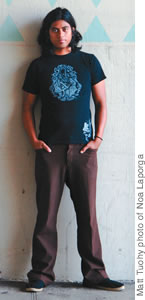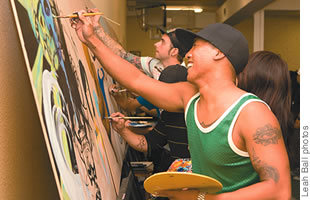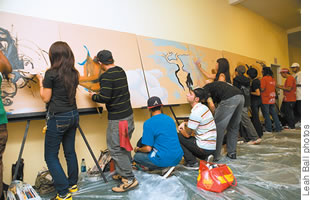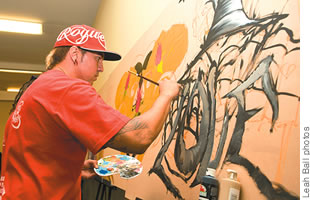From the Ground Up
It’s called Ground Up, and it’s a new movement that looks at art, and creates it, in a whole new way. On unassuming Smith Street in Chinatown, youths

|
On unassuming Smith Street in Chinatown, youths dressed in tight dark jeans sporting Mohawks and dreadlocks and (both guys and girls) wearing makeup could be seen alongside older folks dressed in evening attire, nice shoes and fancy jewelry entering an unmarked building.
Inside, up the stairs and through the first doorway is a feast for the eyes. Painting, graffiti, photography, sculpture and so much more cover the walls. Music in the background ranges from hip-hop to folk while droves of observers and participants stroll through the exhibit’s several rooms, admiring work by artists whose work usually exists only in the streets as graffiti, in tattoo parlors drawn on skin or even at local colleges.
This is the Ground Up movement - a collaboration of artists in music, photography and whatever creative endeavor can be found all rolled up into one. The creator and coordinator is working the room, long hair down to his shoulders, scarf wrapped around his neck and a video camera in hand taping the reactions of his friends, artists and supporters for an upcoming promotional DVD to get the word out for the next show. His name is Noa Laporga.

|
Laporga’s intention behind shows like these is to break down the barriers between different styles and mediums of art. “In the secular or more contemporary museums there are rules and restrictions,” he says, referring to the techniques used for different arts and how they’re classified. “For us, (artists) have the freedom to do whatever is in their heart, or whatever they feel like painting.”
And when he says whatever he means whatever. Among the photographs and paintings in one gallery are a few pieces of furniture that look like they’re intended for patrons to sit on and enjoy the exhibit, but they’re a part of it too. “It’s kinda practical and ... I dunno. I just really like making furniture,” says Brandon Large, who made the lime-green padded armchair, wooden coffee table and bench from long pieces of wood layered together like Lincoln Logs. “I love looking at furniture and instead of buying stuff would rather make it to my own dimensions.” Large says he also was working on a bed for another show and he takes commission orders, too.

|
The most popular attraction at the show, however, is a large, segmented canvas lined up against the wall in the largest room featuring more than 15 artists shoulder-to-shoulder painting whatever comes to mind based on the themes of faith, hope and love.
On one end of the line, Eugene Kristofher, whose day job is waiting tables at The Yard House in Waikiki, paints several different elements around a green and blue skull to represent pressure and pain. “All he (the skull) can do is look up and rely on faith,” he says, referencing to what his portion of the mural must emphasize. All the painting done here is created on the spot. No guidelines were given until the event started that night, leaving artists to paint whatever came to mind regarding the theme. “I’m just freestyling right now,” he continues. “Anything that’s coming into my head I’m trying to paint right now. I don’t have a pre-sketch or anything tonight.”
Kristofher getting the chance to participate in this project and show his art is what the movement is all about, says Laporga. “I think it’s for people to realize that we don’t need a high class gallery for people to enjoy your artwork.”

|
Based on the size of the crowd at this event and that the movement has had shows on the Mainland and is scheduled to tour Europe, it’s clear the movement and idea of lumping several art mediums into one event is catching on. “Now it’s all just like one family,” Laporga says. “Just peace and unity between artists, and that’s the movement basically. And it’s catching on.” An interesting juxtaposition from its turbulent start.
It was slow to begin with,” he admits. “When I started Ground Up, my main goal wasn’t to get a big crowd or anything. We just did it because we loved doing it.” He adds how difficult it was to find a venue to host the shows,
Page 1 of 2 pages for this story 1 2 >
E-mail this story | Print this page | Comments (0) | Archive | RSS
Most Recent Comment(s):




 Del.icio.us
Del.icio.us



